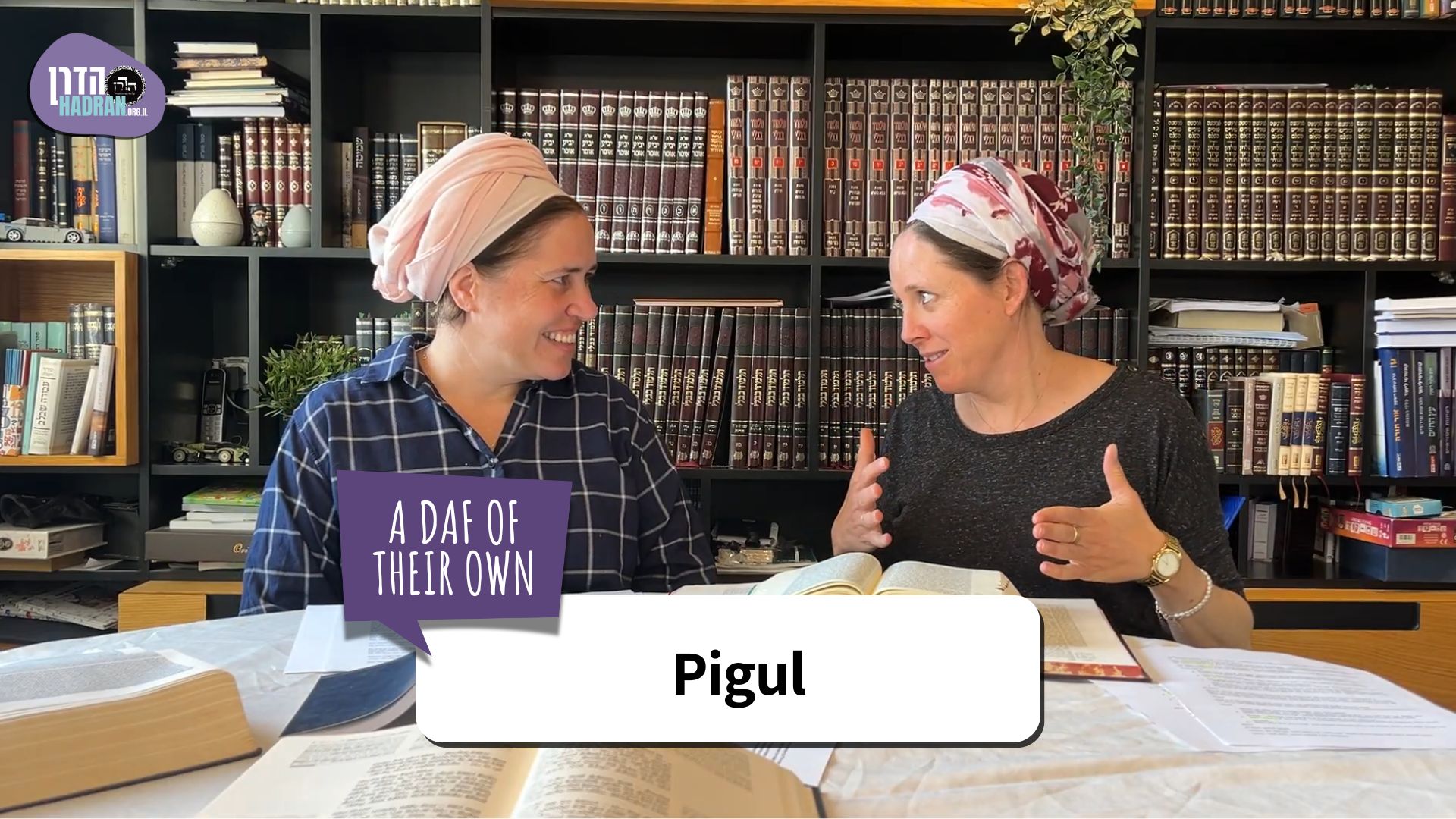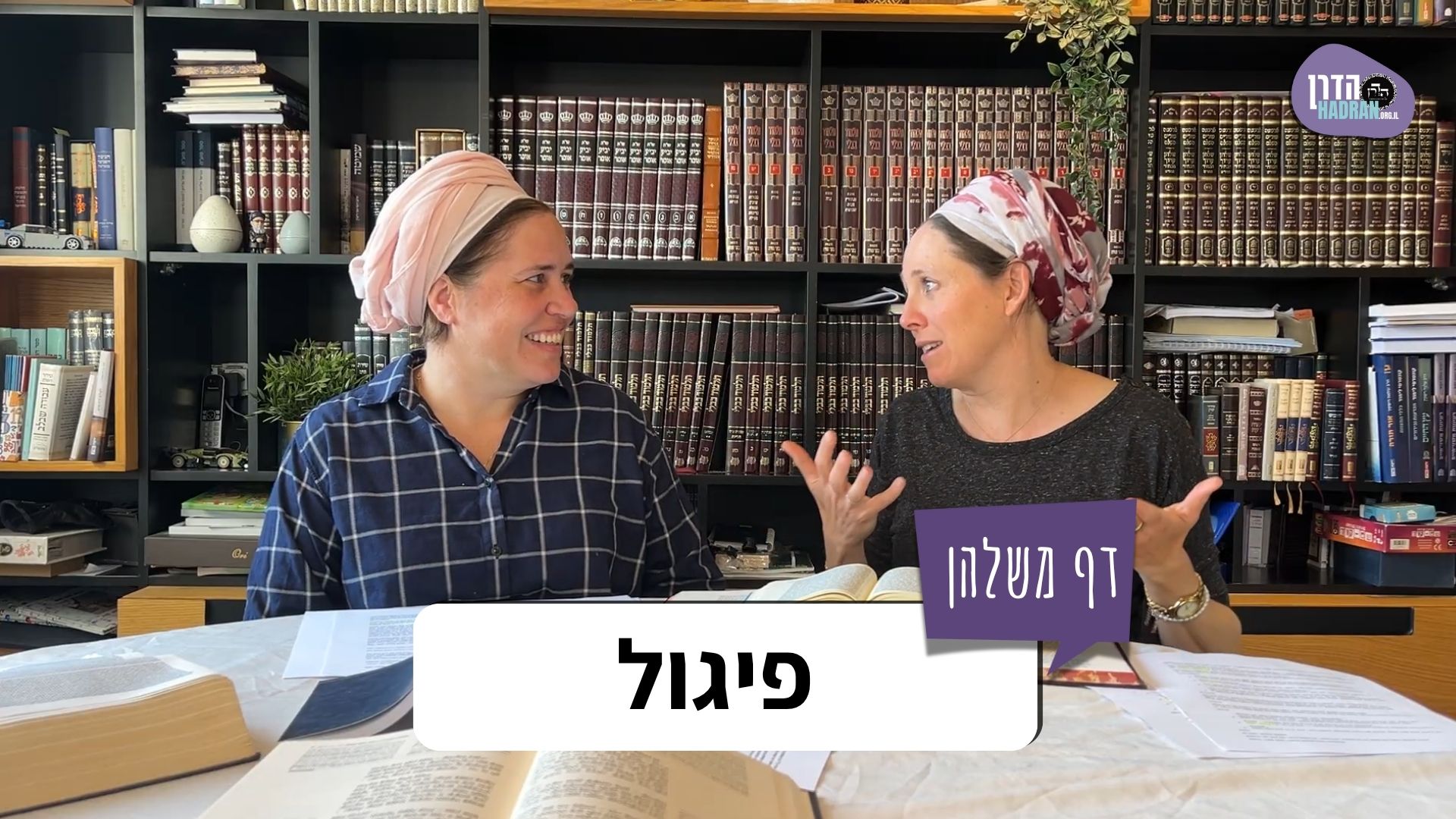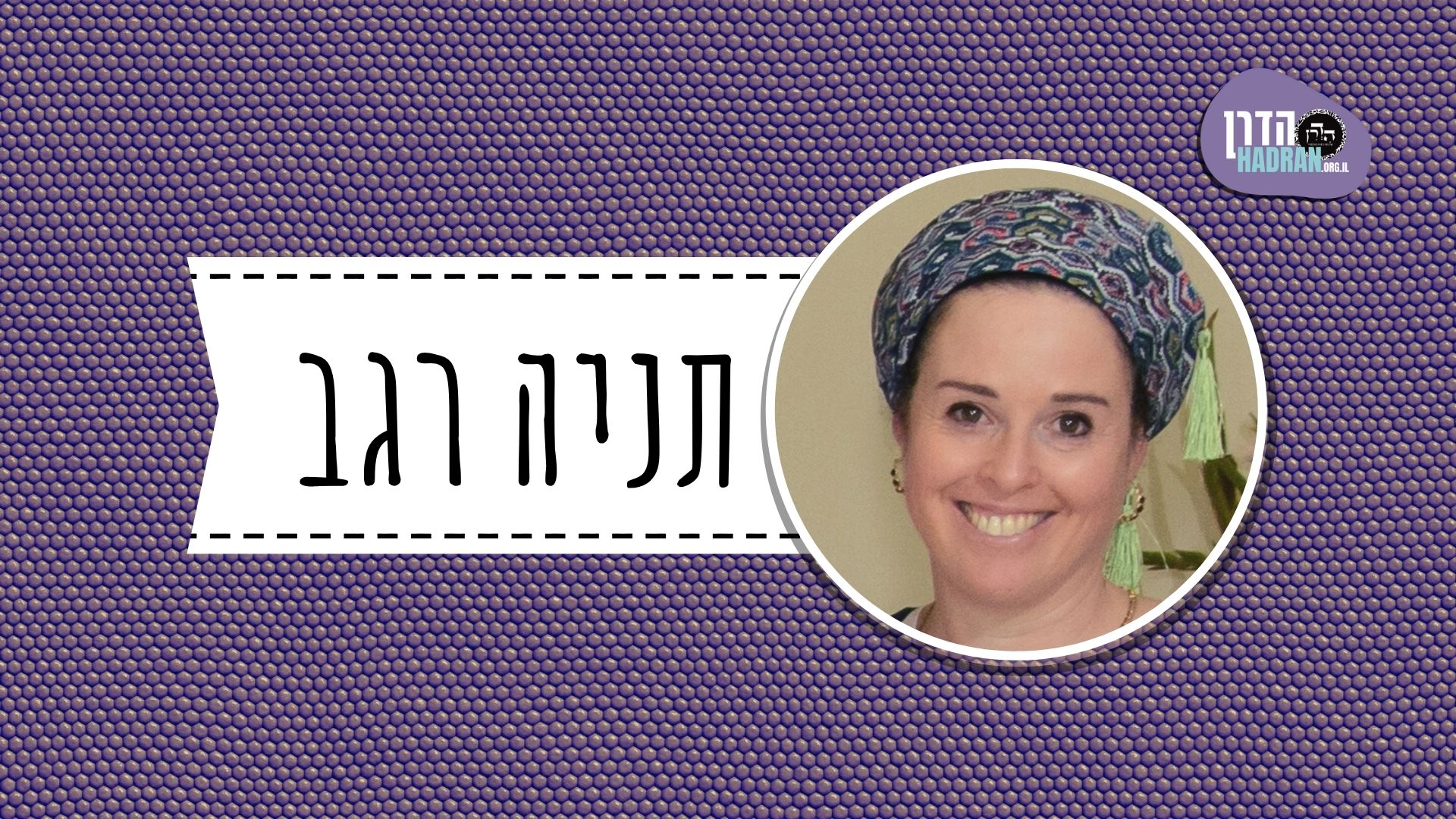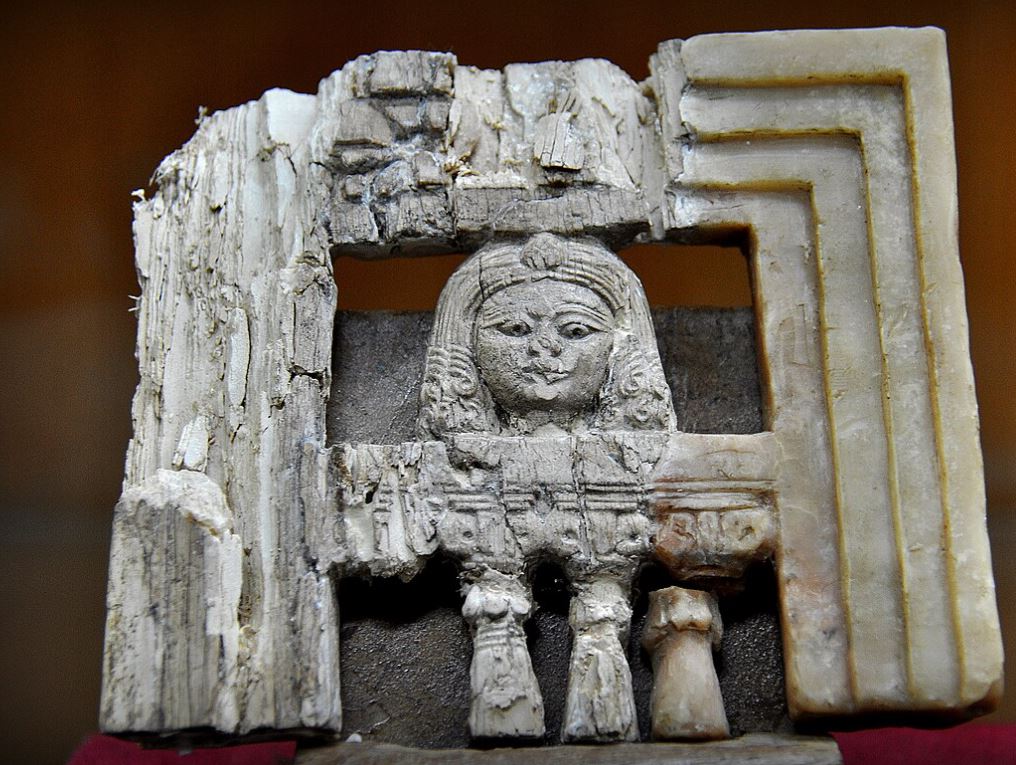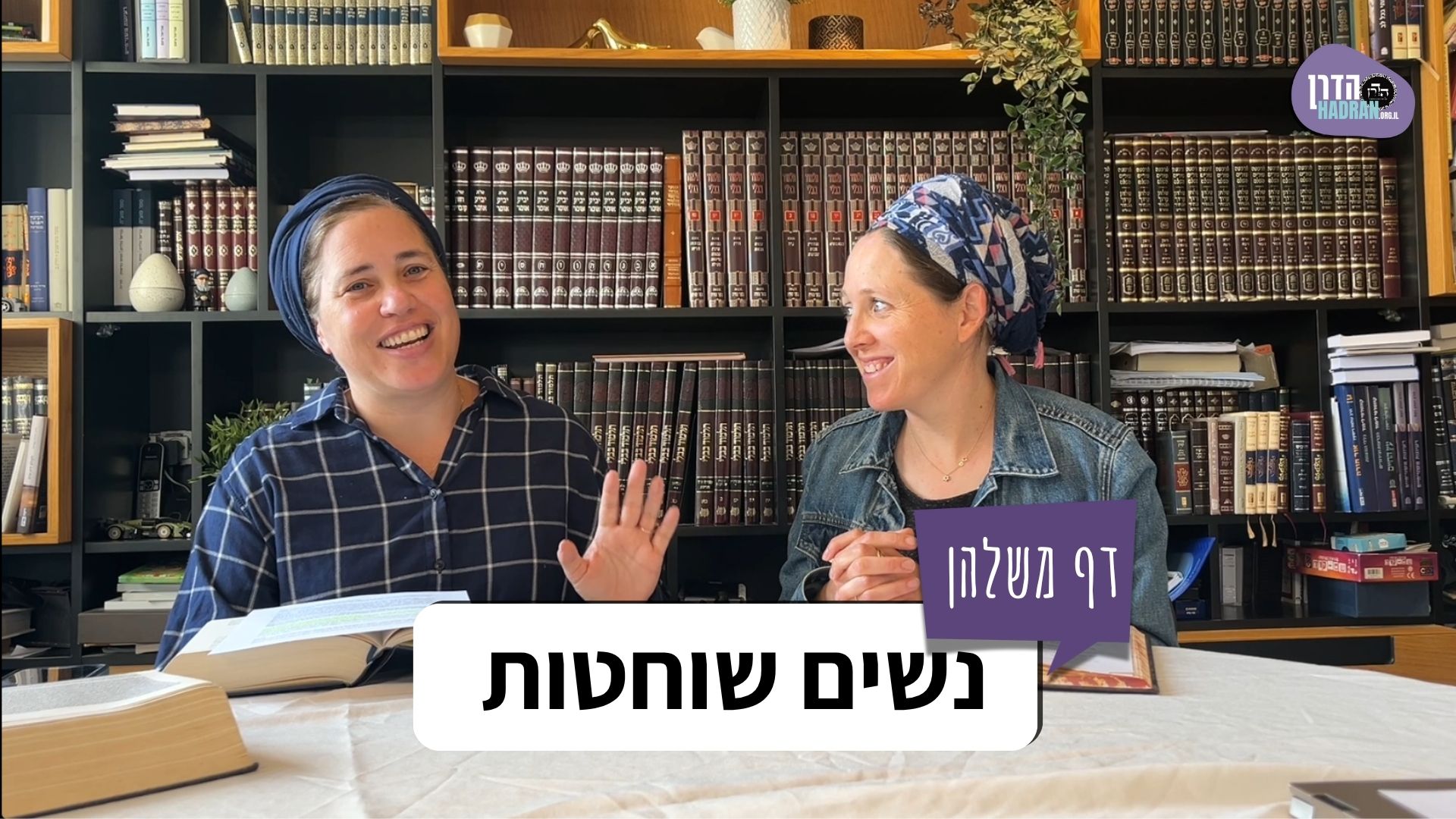More details of treifot are discussed. The gemara brings various cases where rabbis paskened about cases and several questions are raised which relate to core issues regarding methodology of issuing halachic rulings.
This month’s learning is sponsored by Beth Balkany in honor of their granddaughter, Devorah Chana Serach Eichel. “May she grow up to be a lifelong learner.”
Want to dedicate learning? Get started here:


This month’s learning is sponsored by Beth Balkany in honor of their granddaughter, Devorah Chana Serach Eichel. “May she grow up to be a lifelong learner.”
Delve Deeper
Broaden your understanding of the topics on this daf with classes and podcasts from top women Talmud scholars.
New to Talmud?
Check out our resources designed to help you navigate a page of Talmud – and study at the pace, level and style that fits you.
The Hadran Women’s Tapestry
Meet the diverse women learning Gemara at Hadran and hear their stories.
Chullin 44
מחומרי בית שמאי ומחומרי בית הלל עליו הכתוב אומר (קהלת ב, יד) הכסיל בחושך הולך אלא אי כבית שמאי כקוליהן וכחומריהן אי כבית הלל כקוליהן וכחומריהן
And one who wishes to adopt both the stringencies of Beit Shammai and the stringencies of Beit Hillel, with regard to him the verse states: “The fool walks in darkness” (Ecclesiastes 2:14). Rather, one should act either in accordance with Beit Shammai, following both their leniencies and their stringencies, or in accordance with Beit Hillel, following both their leniencies and their stringencies.
הא גופא קשיא אמרת לעולם הלכה כדברי ב”ה והדר תני והרוצה לעשות כדברי ב”ש יעשה
The Gemara objects to the wording of the baraita: This baraita itself is difficult. First you say that the halakha is always in accordance with the statement of Beit Hillel, and then you teach that one who wishes to act in accordance with the statement of Beit Shammai may do so.
לא קשיא כאן קודם בת קול כאן לאחר בת קול
The Gemara responds: This is not difficult. Here, the statement that a person may act as he wishes was made before the Divine Voice emerged and announced that the halakha is always in accordance with Beit Hillel. There, the statement that the halakha is always in accordance with Beit Hillel was made after the Divine Voice issued this ruling.
ואי בעית אימא אף לאחר בת קול ורבי יהושע היא דאמר אין משגיחין בבת קול
And if you wish, say instead that even the statement that a person may act as he wishes was made after the Divine Voice announced that the halakha is in accordance with Beit Hillel, and this statement is in accordance with the opinion of Rabbi Yehoshua, who says: One disregards a Divine Voice that attempts to intervene in matters of halakha. According to him, the dispute between Beit Shammai and Beit Hillel has not yet been decided.
מכל מקום קשיא
The Gemara notes: In any case, Rava’s ruling is difficult. How could he rule in accordance with two contradictory stringencies in order to deem the animal a tereifa?
אמר רב טבות כולה כרב עבדא דכי אתא רמי בר יחזקאל אמר לא תציתו להו להני כללי דכייל יהודה אחי משמיה דרב הכי אמר רב וושט נתנו [בו] חכמים שיעור מכלל דתורבץ הוושט לאו מקום שחיטה הוא וקאמר במשהו
Rav Tavut said: Rava acted entirely in accordance with the opinion of Rav. As when Rami bar Yeḥezkel came, he said: Do not listen to those principles that Rav Yehuda, my brother, formulated in the name of Rav. Although Rav holds that a perforation of any part of the entrance of the gullet renders an animal a tereifa, this is not because it is a location fit for slaughter. Rather, this is what Rav said: The Sages gave a measure defining the portion of the gullet that is valid for slaughter. By inference, one learns that the entrance of the gullet is not a location fit for slaughter. And nevertheless, he says that a perforation in any amount renders the animal a tereifa.
למעלה עד כמה אמר רב נחמן עד כדי תפיסת יד למטה עד כמה אמר רב נחמן אמר רבה בר אבוה עד כדי שישעיר
Since it was mentioned that the Sages gave a measure defining the portion of the gullet that is valid for slaughter, the Gemara asks: How far up the gullet is the upper boundary for valid slaughter? Rav Naḥman said: It is until the point that there remains only sufficient space for a hand to grip the gullet. The Gemara asks: How far down is the lower boundary? Rav Naḥman said that Rabba bar Avuh said: Until the gullet becomes hairy, i.e., until the opening of the rumen, whose lining is hairy.
איני והאמר רבינא אמר גניבא משמיה דרב טפח בוושט סמוך לכרס זהו כרס הפנימי אמאי כי קא שחט בכרס קא שחיט
The Gemara asks: Is that so? But doesn’t Ravina say that Geneiva says in the name of Rav: The lowermost handbreadth in the gullet, adjacent to the rumen, this is the inner rumen? If so, why does Rav Naḥman permit slaughter until the opening of the rumen? When one slaughters within the bottom handbreadth, he is slaughtering in the rumen, and his slaughter should be invalid.
אימא טפח בכרס סמוך לוושט זהו כרס הפנימי איבעית אימא כי קאמר רב בתורא דמשעיר טפי
Rather, say that Rav’s statement should be amended, as follows: The uppermost handbreadth in the rumen, adjacent to the gullet, this is the inner rumen, which is not a valid location for slaughter. By contrast, the lowermost handbreadth of the gullet is a valid location for slaughter. And if you wish, say instead that when Rav says that the lowermost handbreadth of the gullet is considered the rumen, he is referring specifically to a bull, which is especially hairy, and hairs appear even within the lowermost handbreadth of the gullet itself. By contrast, in other animals, the entire lower gullet is a valid location for slaughter.
אמר רב נחמן אמר שמואל תורבץ הוושט שניטל כולו מלחי כשר ותנא תונא ניטל לחי התחתון כשר
§ Rav Naḥman says that Shmuel says: If the entrance of the gullet was completely detached from the jaw, the animal is kosher. And the tanna of the mishna also taught this later (54a): If the lower jaw was detached entirely, it is kosher.
מתקיף לה רב פפא והאיכא עיקור סימנים
Rav Pappa objects to this: How can Shmuel say that if the entrance of the gullet is detached the animal is kosher? But isn’t there ripping of the simanim, the gullet and the windpipe, from their place? This should render the animal a tereifa.
ולרב פפא קשיא מתניתין ניטל לחי התחתון כשר
The Gemara interjects: But according to Rav Pappa, the mishna is difficult as well, since it states: If the lower jaw was detached, it is kosher. If the lower jaw is detached, the windpipe and gullet will necessarily be detached as well, since they are attached to it.
בשלמא מתניתין לרב פפא לא קשיא הא דאיעקור איעקורי הא דאיגום איגומי מעילוי סימנים אלא לשמואל קשיא
The Gemara responds: Granted, the mishna is not difficult for Rav Pappa. This halakha, that the ripping of the simanim renders the animal a tereifa, applies only when the simanim are completely ripped from the jaw. That statement of the mishna, that an animal whose jaw is detached is kosher, is referring to a case where the lower jaw is severed above its connection to the simanim, which themselves remain connected to the remaining flesh of the jaw. But the halakha that the ripping of the simanim renders the animal a tereifa is difficult for Shmuel. How can an animal remain kosher when the entrance of its gullet is removed, if this entails the ripping of the simanim?
לא תימא כולו אלא אימא רובו
The Gemara responds: Do not say that Shmuel deems the animal kosher if the entrance of the gullet was completely detached. Rather, say that he deems it kosher only if it was mostly detached.
והאמר רבה בר בר חנה אמר שמואל סימנים שנדלדלו ברובן טרפה אמר רב שישא בריה דרב אידי הא דאקפל איקפולי התם דאפרוק אפרוקי:
The Gemara asks: But doesn’t Rabba bar bar Ḥana say that Shmuel says: Simanim that were detached in their majority render the animal a tereifa? Rav Sheisha, son of Rav Idi, said: This statement of Shmuel, that the animal is kosher even if the simanim are mostly detached, applies only to a case in which the entrance of the gullet was peeled off from the flesh of the jaw, such that the connected tissue is concentrated in one area. In such a case, the animal might recover. There, where Shmuel deems the animal a tereifa, he is referring to a case in which the simanim were forcibly separated [de’ippruk ipprukei] from the jaw and are connected only by a few discontinuous pieces of flesh. In such a case the animal cannot recover.
ופסוקת הגרגרת: תנא כמה פסוקת הגרגרת ברובה וכמה רובה רב אמר
§ The mishna states: Or an animal with a cut windpipe, cut across its width, is a tereifa. With regard to this the Sages taught: How much must the windpipe be cut to render the animal a tereifa? In its majority. And how much is its majority? Rav says:
רוב עוביה ואמרי לה רוב חללה
The majority of its width, counting the width of the wall of the windpipe itself, the thickness of which is uneven. And some say that Rav says: The majority of its space, the inner area of the cross section of the windpipe, not counting the width of the windpipe wall.
ההיא פסוקת הגרגרת דאתאי לקמיה דרב יתיב וקא בדיק לה ברוב עוביה אמרו ליה רב כהנא ורב אסי לרב לימדתנו רבינו ברוב חללה שדריה לקמיה דרבה בר בר חנה בדקה ברוב חללה ואכשרה וזבן מינה בתליסר איסתירי פשיטי בישרא
The Gemara recounts: There was a certain animal with a cut windpipe that came before Rav, i.e., it was brought for inspection to decide whether it was kosher. Rav was sitting and checking it to see if the windpipe had been cut in the majority of its width. Rav Kahana and Rav Asi said to Rav: Didn’t you teach us, our teacher, that a cut windpipe is measured by the majority of its space? Rav sent the animal before Rabba bar bar Ḥana, who checked it in the majority of its space and deemed it kosher, and purchased meat from it at the price of thirteen plain istera coins.
והיכי עביד הכי והתניא חכם שטימא אין חבירו רשאי לטהר אסר אין חבירו רשאי להתיר שאני הכא דרב לא אסר מיסר
The Gemara asks: And how could Rabba bar bar Ḥana do this, i.e., deem permitted an animal that Rav was going to deem prohibited? But isn’t it taught in a baraita: If a halakhic authority deemed an item impure, another halakhic authority is not allowed to deem it pure; likewise, if he prohibited it, another authority is not allowed to permit it? The Gemara responds: It is different here, since Rav did not actually prohibit the animal. He merely considered doing so, but he sent it to Rabba bar bar Ḥana before issuing a formal ruling.
וכיון דאורי בה חכם היכי אכל מינה והא כתיב (יחזקאל ד, יד) ואומר אהה ה’ אלהים הנה נפשי לא מטומאה ונבלה וטרפה לא אכלתי מנעורי ועד עתה ולא בא בפי בשר פגול
The Gemara asks: And once a halakhic authority has ruled with regard to the animal, even to permit it, how could Rabba bar bar Ḥana eat from it? But isn’t it written: “Then I said: Alas, Lord God, my soul has not become impure; and from my youth until now I have not eaten an unslaughtered carcass, or a tereifa; and no piggul flesh came into my mouth” (Ezekiel 4:14).
הנה נפשי לא מטומאה שלא הרהרתי ביום לבא לידי טומאה בלילה ונבלה וטרפה לא אכלתי שלא אכלתי בשר כוס כוס מעולם ולא בא בפי בשר פגול שלא אכלתי מבהמה שהורה בה חכם משום ר’ נתן אמרו שלא אכלתי מבהמה שלא הורמו מתנותיה
The Sages interpreted the verse as follows: “My soul has not been become impure” means that I did not think of sexual thoughts during the day so as to come to the impurity of a seminal emission at night. “I have not eaten an unslaughtered carcass, or a tereifa” means that I never ate the flesh of an animal that was in danger of imminent death, leading one to say: Slaughter it, slaughter it quickly, before it dies. “And no piggul flesh came into my mouth,” means that I never ate from an animal with regard to which there was uncertainty whether it is prohibited and a Sage issued a ruling to permit it. The Sages said in the name of Rabbi Natan: The phrase means that I never ate from an animal from which the gifts of the priesthood, the foreleg, jaw, and abomasum, were not separated. The above acts are technically permitted but unseemly. How, then, could Rabba bar bar Ḥana consume the meat of this animal?
הני מילי מילתא דתליא בסברא רבה בר בר חנה אגמריה סמך
The Gemara responds: This statement, that it is unseemly for a halakhic authority to rely on his own ruling to permit the meat, applies only to a matter that depends on reasoning. Rabba bar bar Ḥana relied on his learning, i.e., a received tradition. There is nothing unseemly about relying upon a received tradition.
ותיפוק ליה משום חשדא דתניא דן את הדין זיכה וחייב טימא וטיהר אסר והתיר וכן העדים שהעידו כולן רשאין ליקח אבל אמרו חכמים הרחק מן הכיעור ומן הדומה לו
The Gemara objects: But let one derive that Rabba bar bar Ḥana should not have purchased the meat due to suspicion, as it is taught in a baraita: If one issued a judgment, acquitted or convicted, deemed impure or pure, prohibited or permitted; or if witnesses testified with regard to a case, in all of these instances the judges or witnesses are allowed to purchase the item that they deemed permitted. But the Sages said: Distance yourself from unseemliness and from things similar to it. If so, Rabba bar bar Ḥana should not have purchased the meat that he himself permitted.
ה”מ מידי דמזבין משומא הכא מתקלא מוכח כי הא דרבה שרא טרפתא וזבן מינה בישרא אמרה ליה בת רב חסדא אבא שרי בוכרא ולא זבן מיניה בישרא
The Gemara responds: This statement applies only to an item that is sold based on an appraisal of its value and not by standard measure. In such cases onlookers might suspect that the judge is receiving a favorable price in return for his judgment. But here, the weight of the meat proves that the judge is not receiving a discount, but is paying the standard price. This is like that incident where Rabba permitted a possible tereifa for consumption and bought meat from it. His wife, the daughter of Rav Ḥisda, said to him: Father permitted a firstborn animal, declaring that it possessed a blemish that renders it permitted for consumption, but did not buy meat from it. Why are you acting differently?
אמר לה ה”מ בוכרא דאשומא מזדבן הכא מתקלא מוכח מאי איכא משום אומצא מעלייתא כל יומא אומצא מעלייתא זבנו לי
Rabba said to her: That matter applies to a firstborn, which is sold based on appraisal of its value. Here, the weight of the meat proves that I am paying the standard price and not unfairly deriving benefit from my judgment. What suspicion is there in this case? Will people suspect me because I received a superior piece of meat? Every day they sell me a superior piece of meat.
אמר רב חסדא איזהו תלמיד חכם זה הרואה טרפה לעצמו ואמר רב חסדא איזהו (משלי טו, כז) שונא מתנות יחיה זה הרואה טרפה לעצמו
The Gemara cites an aphorism: Rav Ḥisda says: Who is a Torah scholar? This is one who sees his own tereifa. In other words, when the status of his own animal is uncertain, he deems it prohibited without concern for his own monetary loss. And Rav Ḥisda says: Who is referred to by the verse: “He that hates gifts shall live” (Proverbs 15:27)? This is one who sees his own tereifa. He is careful to avoid deriving benefit from that which is not his own, and even from items that are his concerning which it is questionable whether or not they are permitted.
דרש מר זוטרא משמיה דרב חסדא כל מי שקורא ושונה ורואה טרפה לעצמו ושימש תלמידי חכמים עליו הכתוב אומר (תהלים קכח, ב) יגיע כפיך כי תאכל אשריך וטוב לך רב זביד אמר זוכה ונוחל שני עולמות העולם הזה והעולם הבא אשריך בעולם הזה וטוב לך לעולם הבא
Mar Zutra taught in the name of Rav Ḥisda: Anyone who reads the Torah and studies the Mishna, and sees his own tereifa, and has served Torah scholars to learn the ways of halakhic judgment, about him the verse states: “When you eat the labor of your hands, happy shall you be, and it shall be well with you” (Psalms 128:2). Rav Zevid says: Such a person merits inheriting two worlds, this world and the World-to-Come. When the verse states: “Happy shall you be,” it means in this world, and when it states: “And it shall be well with you,” it is referring to the World-to-Come.
ר’ אלעזר כי הוו משדרי ליה מבי נשיאה מידי לא שקיל וכי הוו מזמני ליה לא אזיל אמר לא קא בעי מר דאיחי דכתיב ושונא מתנות יחיה רבי זירא כי משדרי ליה לא שקיל כי הוו מזמנין ליה אזיל אמר
With regard to the verse: “He that hates gifts shall live,” the Gemara relates that when they would send Rabbi Elazar some gift from the house of the Nasi, he would not take it. And when they would invite him, he would not go there. When declining these offers, he said to them: Does Master not desire that I live? As it is written: “He that hates gifts shall live.” By contrast, when they would send a gift to Rabbi Zeira, he would not take it, but when they would invite him he would go. He said in explanation:


